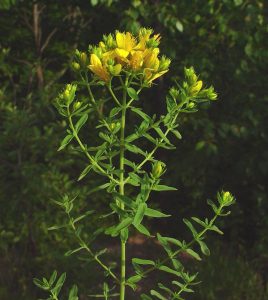Hi! I’m Theresa, a HiLIFE Trainee 2024, and I’m now in my fifth week of my traineeship in the Eco-Evolutionary Dynamics Lab by Frédéric Guillaume (UH, OEB), in collaboration with Anniina Mattila from LUOMUS. The goal of my project is to predict the species’ range shift of the St. John’s wort (Hypericum perforatum) across Finland following climate change. That means I want to know in which places the St. John’s wort will be able to persist, in which places it will go locally extinct and which places it will newly colonize. As the temperatures in Finland are going to increase, I expect the St. John’s wort populations to move north since the climate is cooler in nothern latitudes. However, it is not that easy because species’ responses to climate change depend on many different factors. And that is exactly why I will use computer simulations!

But how did I end up choosing this project?
I’m a first year Master’s Student in Ecology and Evolutionary Biology at the University of Helsinki. I’m originally from Munich, Germany, and I did my Bachelor’s in Molecular Ecosystem Sciences at the University of Göttingen, Germany. During that I discovered ecological modeling and loved it because I enjoy programming and describing nature with math. For my B.Sc. thesis I modeled bird diversity in an agricultural system. I also started to be very fascinated about evolution and genetics, with which I came in touch during my Bachelor’s but never had the opportunity to work with it. Until now! Early in my Master’s at the University of Helsinki I found the Eco-Evolutionary Dynamics Group, which combines modeling with the genetic mechanisms behind evolution. It’s a match!
How will I be able to predict the future?
I must admit, that’s a very bold statement and of course I’m not a clairvoyant. But putting some assumptions and limitations aside, such simulations are indeed very powerful in forecasting the future, or at least make really good guesses. So how will I make really good guesses? The answer is: A dynamic eco-evolutionary modeling approach, that is based on individual-based genetically and spatially explicit simulations, which in turn are calibrated with empirical data. But what on earth does that even mean?
A dynamic eco-evolutionary modeling approach allows a more integral way of describing species’ responses to a changing environment than most other modeling approaches. The magic behind it is that it includes 1. the ability of a population to colonize new areas with more favorable climatic conditions and 2. its capacity to genetically adapt to new conditions.
This approach will be realized by running individual-based genetically and spatially explicit simulations using Nemo, a tool developed by the Guillame Lab. Nemo simulates each plant individually including its genetic architecture, life cycle and location. And that gives the possibility to include evolutionary as well as ecological key processes such as mutation, genetic drift, selection, and dispersal.
These simulations take in many different parameters and this is where the empirical data comes into the equation. As I want my simulation to represent reality as accurately as possible, I will extract the needed parameters from real-world data, such as climate data, species distribution data, genetic data and thermal performance data. Then, I will plug in those parameters into the simulation together with IPCC climate change scenarios and observe what happens. Exciting!

Where am I at?
I spend the last few weeks geting a grasp of what I need for my simulation, how I will get it and how everything is connected. Now as I have a plan, the first thing to do is relating current climate data to the current species distribution. That will help me getting an idea which climatic conditions are suitable for the St. John’s wort. And that in turn is one of the very important parameters needed in my simulation. In the upcoming months I will analyze many more data sets until I can feed the simulation with real-world paramters and finally answer the question: How will the finnish St. John’s wort populations do in the future?
